Back to the Future! Episode 2 - "In which our intrepid time travelers continue their quest"
Happy New Year, everyone, Habaneros and all men and women of goodwill, throughout the planet. Hopefully 2006 is being good to you so far. And now, let us continue our travels - set the dial on the Time Machine to about 100 years ago, in a place and time now far, far away...eerily opening a window into the past, showing that the future of Havana, in many ways, would reflect that past more than we would have liked.
I said we would travel "to about 100 years ago." Oops, I was wrong! We're going back 107 years for starters - how time flies!
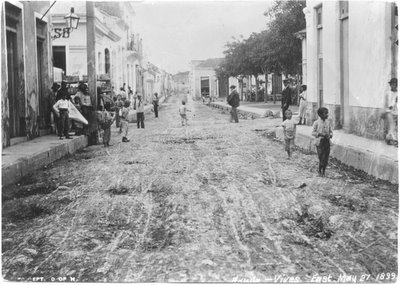 The photo's caption is self-explanatory - a view of Aguila and Vives streets, looking east, May 27, 1899. The photo was taken during the US administration, less than a year after the Spanish-American War ended. The small legend on the left of the photo, at the bottom reads: (illegible) "Dept D of H." This could have been printed by a health department or similar organization to document necessary street work and drainage needed to improve conditions. Don't forget those were the days of yellow fever, one of many mosquito-borne diseases.
The photo's caption is self-explanatory - a view of Aguila and Vives streets, looking east, May 27, 1899. The photo was taken during the US administration, less than a year after the Spanish-American War ended. The small legend on the left of the photo, at the bottom reads: (illegible) "Dept D of H." This could have been printed by a health department or similar organization to document necessary street work and drainage needed to improve conditions. Don't forget those were the days of yellow fever, one of many mosquito-borne diseases.This reminds me, for some reason, how years later, my buddies, sister, cousins, etc, would run behind health department jeeps spraying what I believe was DDT, getting into the white clouds of pesticide mist, playing around in the unusual but in its own way pleasant chemical smell - until horrified parents or passers-by would yell at us to get out of the poisoned atmosphere. We called the pesticide jeep "la tifa." Can't say exactly what that translates to, except it has nothing to do with Queen Latifah. I am sure by now many of your are shaking your heads in disbelief at this quaint non EPA-approved custom, but remember the 50's were the days before Nanny Government started telling us how to be good boys and girls. Forgive me. I was young and stupid. Now I am old and stupid. Say, could chasing "la tifa" too many times turn people into ugly, bad-mannered, ill-humored green fatigue wearing types who impose Nanny Governments From Hell?
Here is another Cuban street scene, this one dating to about 1902-1903.
 The caption, by Pedro Pablo, states: "Angel Hill (Loma del Angel) - before, the Five Corners (Las Cinco Esquinas); prior to that, Coffin Alley (Callejon del Ataud) after Sword (Espada) street."
The caption, by Pedro Pablo, states: "Angel Hill (Loma del Angel) - before, the Five Corners (Las Cinco Esquinas); prior to that, Coffin Alley (Callejon del Ataud) after Sword (Espada) street."Such interesting street names/places - Angel Hill, Coffin Alley (!) - did grave matters take place there? Sorry, couldn't resist engaging in the lowest form of humor. Sword street - did swashbucklers and duelers congregate there to settle their differences by the clash of Toledo steel? It would be wonderful to know how these places came to be given their colorful names - bet Pedro Pablo would have known, but unfortunately he is not available.
If we're going to talk about coffins and streets where perhaps coffinmakers plied their trade - hence the name of the street, perhaps - we may as well take a little macabre detour, or tour, for those who enjoy horror literature and movies, and otherwordly places, and visit locales no city can do without...


Because, in the end, no one gets outta here alive. The photo on top is of the city morgue, captioned "Municipal (City) morgue, today Avenue of The Missions (Avenida de Las Misiones)." What missions were carried out at the Avenue of Missions, have no earthly - or UNearthly idea. And the one on the bottom would be familiar to most, if not all Habaneros, then and now - and to visitors who make their morbid pilgrimages there, as do those who want to sneak a peek at Jim Morrison's or Oscar Wilde's graves in Pere-Lachaise Cemetery - the gate or portico to Havana's biggest cemetery, Cementerio de Colon. Pedro Pablo's comments on the back of the photograph: "Gate of Colon Cemetery - without the statues. To place the statues, it was necessary to cut them in half. While being installed (the statues) a worker died." Ghoulish, isn't it? An unfortunate laborer dying in a work accident at a cemetery. Regretfully, there is no name - wonder if the poor man rests in Colon cemetery to this day? Perhaps somewhere there is an old newspaper of the time to give us the sad details. Whoever you are, rest in peace.
Here are some contemporary photos - taken about 6 years ago, of Colon Cemetery gate or portico - you can see the statues on top of the gate, and maybe say a prayer for that unknown laborer who perished placing them there.

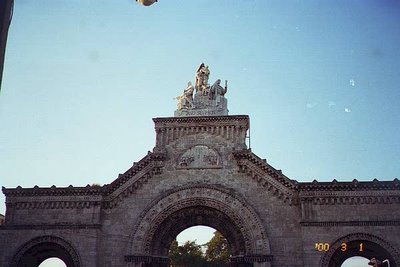
These came, not from "our" vault, but from the website of another talented photographer - Julius Nicolai Von Schmidt. Don't let the name fool you - he's Cuban.
There are all kinds of Cubans, all over. A couple of years ago, while interviewing a lovely lady, who I thought was from Finland...found out she was born in Cuba, of Finnish parents. She told me there was once a small colony of Finns in Cuba. Someone ought to do a blog on Cuban ethnicity, a fascinating subject.
If you wish to see Mr. Schmidt's wonderful work and his images of Cuba past, go here, the source for the contemporary photographs of Colon Cemetery -
Pray he does not mind if I display some of his photos, so that you may get an idea of the changes - for good and bad - Havana has undergone over the years. His website is fantastic, and you should explore or navigate through it. You will not be disappointed.
Alright, enough about cemeteries and other end-of-the-road subjects. Let us go to the park; it is a beautiful day. It is a beautiful day as I write these words, somewhere in Florida. Clear, blue skies, if a bit chilly. Hope it is not too cold where you are so that you can be inspired to go to your city's parks and enjoy them.
Going to the park was somewhat of an event in Havana. Most people's homes and apartments did not really have enough land around them to make a proper "play area" by the standards of most kids. In fairness, however, kids are very adaptable and will make the best of the space they have, limited only by their imagination. Like the time cousin Fernando flipped a wooden office desk at his parents' so that, magically, it became a "Sherman tank" crewed by two daredevils, slugging it out with Kraut panzers in the Normandy or the Ardennes of our imagination...Regardless, much play would take place in local parks and parklands. Mom and dad would take me to places like "La Coronela (The Lady Colonel - bet there's a story there)" and "El Laguito (The Little Lake);" and there was "El Bosque de La Habana," literally, the "Woods or Woodlands of Havana." Yes, there were remnants of the woodlands that once had dotted the site of Havana.
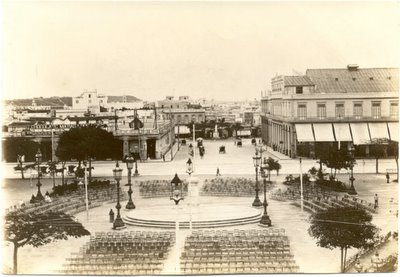 "Parque Central," reads Pedro Pablo's note - Central Park. Yes, Havana had a Central Park too. Eat your heart out, New York! Did you ever go to Central Park? Did you ever gorge on Matias Lopez Chocolate, advertised on the building in the middle background and to the left of a tiny-looking statue , as "the best in the world?"
"Parque Central," reads Pedro Pablo's note - Central Park. Yes, Havana had a Central Park too. Eat your heart out, New York! Did you ever go to Central Park? Did you ever gorge on Matias Lopez Chocolate, advertised on the building in the middle background and to the left of a tiny-looking statue , as "the best in the world?" Here is another view of Central Park, from Neptuno (Neptune) street -
 The photo is captioned "El Diario de la Marina, today Hotel Plaza." "El Diario de la Marina" was a very important newspaper in Havana, indeed, in all of Cuba. It was owned by the prominent Rivero family, and published for over a century, until finally silenced, because the bearded brute could not handle the truth, on 11 May, 1960. Pedro Pablo unfortunately does not give us a clue as to when Diario de la Marina's building became the Hotel Plaza. However, on a web site I will not name, as it promotes travel to today's Cuba - and yours truly will not be a party to that as long as ordinary Cubans in Cuba do not have the right to enjoy the same amenities and hotels foreigners do - the hotel is said to "have been inaugurated on December 29, 1909."
The photo is captioned "El Diario de la Marina, today Hotel Plaza." "El Diario de la Marina" was a very important newspaper in Havana, indeed, in all of Cuba. It was owned by the prominent Rivero family, and published for over a century, until finally silenced, because the bearded brute could not handle the truth, on 11 May, 1960. Pedro Pablo unfortunately does not give us a clue as to when Diario de la Marina's building became the Hotel Plaza. However, on a web site I will not name, as it promotes travel to today's Cuba - and yours truly will not be a party to that as long as ordinary Cubans in Cuba do not have the right to enjoy the same amenities and hotels foreigners do - the hotel is said to "have been inaugurated on December 29, 1909." There is an interesting connection between our family and Diario de la Marina. One of my father's aunts, Aurora Quiroga, sister of Elvira Quiroga-Pedro Pablo's mother-married one of the Diario's journalists, Atanasio Rivero Sr. Despite the name, he was no relation to the owning Rivero family. My father explained that Atanasio Rivero Sr. wrote a literary column in the Diario, for many years, under the title "Duelos y Quebrantos," or "Duels and Afflictions." My translation may not convey the meaning as accurately as it should. He wrote much about Cervantes and other authors, but apparently Cervantes - whom you should recognize as the author of "Don Quixote," was his favorite subject. As evidenced by Mr. Rivero Sr.'s headstone at the Almudena cemetery in Madrid, which reads, according to dad: "Here Lies The Ingenious Knight (a definite allusion to "Don Quixote") Don Atanasio Rivero y Azpiri." In Castilian, for those who have mastered the Iberic tongue, "Aqui Yace El Ingenioso Hidalgo Don Atanasio Rivero y Azpiri." If you are in Madrid and happen to wander through Almudena cemetery, perhaps you can stop by and say hello to this Ingenious Knight.
And since we've just been to Central Park at Neptuno street, we may as well continue on to Prado and Neptuno streets, and watch the men in their suits and the ladies with their hats and umbrellas catch some shade under the trees lining the median...
 The photo caption: "Prado and Neptuno - urban horse-drawn trolley." Looks like a 3-horsepower model to me. Check out the spiffy carriage on the right - no doubt the latest 1-horsepower sports model around 1900.
The photo caption: "Prado and Neptuno - urban horse-drawn trolley." Looks like a 3-horsepower model to me. Check out the spiffy carriage on the right - no doubt the latest 1-horsepower sports model around 1900.Now look at these contrasting images of the same places, from the Von Schmidt website, 50-100 years later.
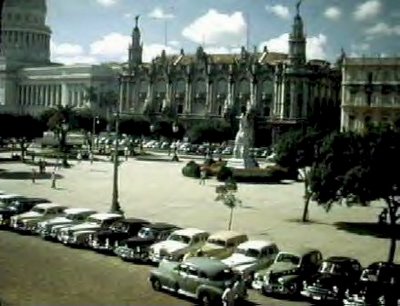 Central Park, 1947 - more autos than you see in Central Park today. I suppose, for some folks, that's progress. I suppose the bearded grouch with his fleet of Mercedes-Benz cars would just as soon let Habaneros ride the 3-horsepower trolleys so popular in 1900-1903...
Central Park, 1947 - more autos than you see in Central Park today. I suppose, for some folks, that's progress. I suppose the bearded grouch with his fleet of Mercedes-Benz cars would just as soon let Habaneros ride the 3-horsepower trolleys so popular in 1900-1903...
Here is another of Central Park at Prado and Neptune streets, also in 1947
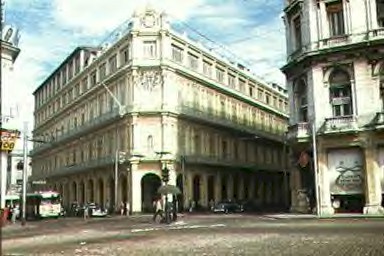 Remember Hotel Plaza and Diario de la Marina? Here is the Plaza in 1947. The surrounding area has definitely changed by then.
Remember Hotel Plaza and Diario de la Marina? Here is the Plaza in 1947. The surrounding area has definitely changed by then.And here is the Plaza in Anno Domini 2000...

Notice the bracing to the building on the right - wonder how long it has been there? No doubt an example of urban-renewal-by-neglect; things do not seem to be looking up for poor Havana these days, rather they seem to be falling down - something which the guy in charge seems to be doing himself, these days. Maybe somebody should brace him in - with iron bars - into a very, very, small box. There, he could make the best of the available space, limited only by his warped imagination...
Here is a shot of Prado and Neptuno in 1947 - with the median and the trees -
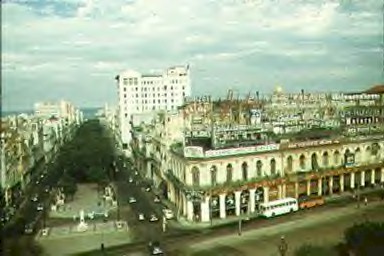
How many things have changed? For one thing, the 3-horsepower trolleys and 1-horsepower carriages have been replaced by more modern, many-horsepowered, conveyances, mostly from Detroit; Fords, Chevys, Dodges and later, until 1960, others like Corvettes, Mercedes-Benz, Volkswagen, MG, Renault (remember those?), Fiat, and many others, like the Isetta - remember that one? Corvairs too - I have a Corvair story for you, but later.
Let us continue our walks through the parks in 19th-early 20th Century Havana. We have three more to visit in this episode.
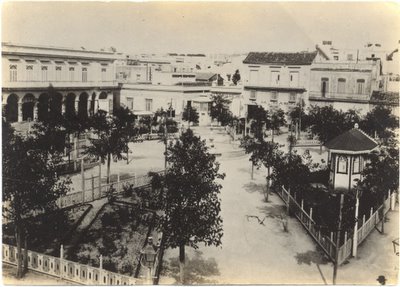 "Parque de San Juan de Dios," writes Pedro Pablo. "Park of St. John of the Lord," is my best translation - do not recall being there, but then, that would have been 50-60 years later. The geometry of the image is interesting - triangles, diagonals, hexagons/pentagons.
"Parque de San Juan de Dios," writes Pedro Pablo. "Park of St. John of the Lord," is my best translation - do not recall being there, but then, that would have been 50-60 years later. The geometry of the image is interesting - triangles, diagonals, hexagons/pentagons. "Parque de la India;" literally, "Park of the Indian Maiden." Taken on a sunny day, as evidenced by the shadows on the sidewalks and walkways.
"Parque de la India;" literally, "Park of the Indian Maiden." Taken on a sunny day, as evidenced by the shadows on the sidewalks and walkways.And here are two views of the same park, from Von Schmidt - taken at different angles;
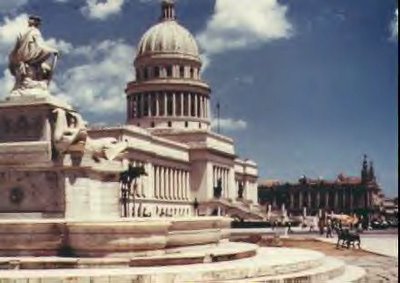 This one from 1947-the sky was beautiful on that day.
This one from 1947-the sky was beautiful on that day. And this one, from 1997 - almost 100 years separate the black and white image from the most recent one. At the time the turn-of-the-20th-Century photograph was taken, the Cuban "Capitol" had not been built. The sky was mostly cloudy that day in 1997 - was this Nature's way of commenting on, not only the physical, but also the political ambiance??
And this one, from 1997 - almost 100 years separate the black and white image from the most recent one. At the time the turn-of-the-20th-Century photograph was taken, the Cuban "Capitol" had not been built. The sky was mostly cloudy that day in 1997 - was this Nature's way of commenting on, not only the physical, but also the political ambiance??
"La Punta (The Point) park with Neptune's fountain; City jail or Detention center; 'La Cucaracha,'" small engine which took passengers to Vedado (a close suburb); Headquarters of the Engineers, place where the Medical Students were shot in 1871."
This should not properly be called a park, but it is a parklike area. There is a lot of history revealed in the description written by Pedro Pablo, which could fill volumes by itself. "La Cucaracha" was a small, steam-powered engine, obviously able to haul two carloads filled with passengers. Here you have a foreshadowing of the coming motorization of La Habana's streets. The Engineer's Quarters or Headquarters are to the right of the large building, which is the jail. If you want to know more about the Students of Medicine executed in 1871, and why they came to such sad end, you can read about it in "Cuba - The Pursuit of Freedom," by Hugh Thomas. You may also visit many links on the web, for example, this one:
It is in Spanish, but no doubt you can find information about this tragic episode, one of many which Cuba has experienced in the past 100+ years, using key words, such as "execution of medical students Cuba 1871." Good 'ol Google and other capable search engines ought to do the trick.
Some things haven't changed since 1871, in Havana, and other places...
-To be continued-
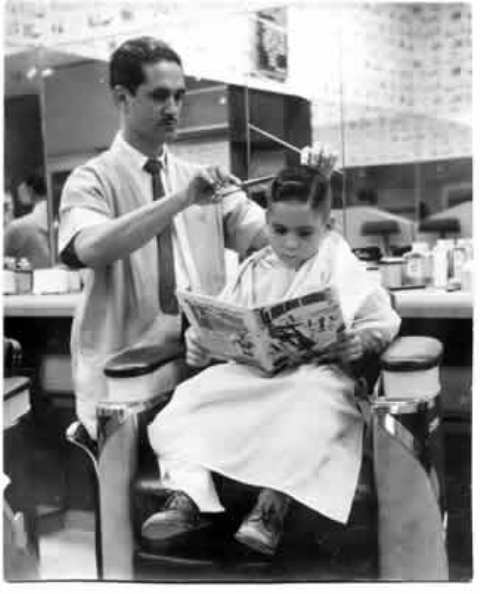
3 Comments:
Thank you, you had my absolute and total concentration through out.
Serena
I, too, ran behind the jeeps spraying DDT! But this was after we moved from calle "J" to Altahabana. If you followed Carretera Rancho Bolleros out of La Habana you would arrive there in about a half-hour.
Your photo references and commentary are priceless. This is a great blog! I will visit often. Thanks for all the time you invest in it.
Carlos Eire recounts chasing the pesticide jeep in his book, as well. Sounds like fun.
Post a Comment
<< Home